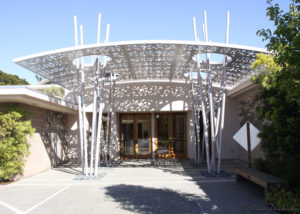 This is one of a series of articles I wrote for the monthly Bulletin of Peninsula Temple Sholom in Burlingame, Calif.
This is one of a series of articles I wrote for the monthly Bulletin of Peninsula Temple Sholom in Burlingame, Calif.
In our haste to get to services, classes or committee meetings, we sometimes forget to appreciate the beautiful physical environment at Peninsula Temple Sholom.
Next time you visit the Temple, please take a moment to look around. Go into the Sanctuary and examine the new lectern, with its subtle Menorah design and exquisite craftsmanship. Look around the Sanctuary and Social Hall, with the many Jewish themes from the Star of David on top of the dome to the menorahs and tallitot on the walls and windows. It’s a big space that inspires peace and introspection.
In the foyer, on the side near the Social Hall, see the large plaque honoring our synagogue’s founders and charter members. This plaque was recently installed by our hard-working History Committee. Near the Memorial Wall you’ll see a freestanding menorah. It was donated a few months ago and adds character to this part of the building.
On the way into the main sanctuary from the foyer, of course, you have the joyous statue that always makes me think about Rabbi Raiskin z”l. Elsewhere in the foyer, and in the waiting area to the administrative offices, there’s plenty of framed artwork hanging for you to study and enjoy.
If you are like me, you have left noseprints on the glass to our Sholom Women Judaica Shop as you look at the beautiful objects in their window display. There’s another window display on the opposite wall. These add to our foyer’s appearance.
Move outside the building. The canopy over the front entrance is a starry sky of peace over our pomegranate grove — an artistic rendering of the Hashkiveinu prayer we sing together every Friday night.
Behind a bench near the pomegranate grove, find a plaque that quotes Psalm 34, “Seek Peace and Pursue It.” The plaque commemorates the founding of Peninsula Temple Sholom in 1955 and the construction of our Sanctuary and Social Hall in 1960-1961.
Turn around and see the new landscaping in our parking lot. The greenery was installed shortly before the High Holy Days this year, and gives members and guests a gentle, peaceful first impression of our campus. (Thank you for not walking on our landscaping!)
Artwork is everywhere at PTS, and there’s much more to admire than has been described above. Everywhere you look, you will see beauty. We appreciate the hard work of Diane Goldman and Eileen Battat, who co-chair our Fine Arts & Beautification Committee; Gary Fishtrom, who heads our Facilities Committee; Amy Mallor, our Executive Director; Mariano Sanchez and our team of custodians who maintain everything at PTS; and of course, the generosity of our members for endowing the art and gardens.
Go ahead, take that moment to look around the Temple. The worship service, the class, the meeting will wait.






